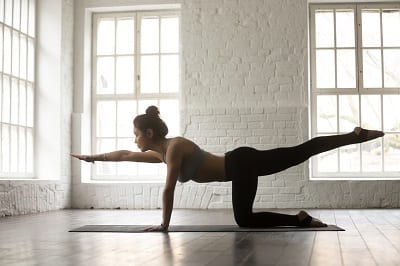Target Body Part: Equipment Needed:
Abs, Back, Butt/Hips No Equipment
Step 1
Starting Position: Come to a hands and knees position on an exercise mat positioning your knees underneath your hips and the crease of your wrists directly underneath your shoulders. Your fingers should be pointing forward.
Step 2
Engage your core and abdominal muscles. Imagine you are tightening a corset
around your waistline. Keep your spine in a neutral position, avoid any excessive sagging or arching. Pull the shoulder blades toward your hips.
Step 3
Upward Phase: In this exercise you are attempting to move the opposite arm and leg simultaneously. It is very helpful to use a mirror to help you with form adjustments. Begin by slowly lengthening the left leg until it is long and strong. Lift the leg off the floor until it is at or near parallel to the floor. The leg should not be lifted above hip height. This will help to avoid upward rotation at the hip.
Step 4
Slowly raise and straighten right arm. Attempt to raise the arm until it is at, or near parallel, to the floor. Do not allow the shoulders to tilt upward. Keep both shoulders parallel to the floor. Your head is an extension of your spine and should remain aligned with the spine throughout the movement. Do not lift the head or let it sag downward.
NOTE: The leg and arm should only be raised as to heights that allow you to maintain the shoulders and pelvis in parallel to one another, the core engaged and the spine in neutral position.
Step 5
Downward Phase: Gently lower yourself back to your starting position, maintaining balance and stability in the shoulders, pelvis and torso.
Step 6
Alternating Sides: During this phase of changing sides, work very hard to keep the abdominals engaged. Imagine knitting your ribs together as though you were lacing up a tennis shoe. When you change sides, try to do so with minimal weight shift. Do not flop from one side to the next. Maintain balance and control.
The bird-dog is an excellent exercise to train the body how to stabilize the lumbar spine (low back) during upper and lower extremity movement. Never exceed your ability to control movement in the low back.
ACE ARTICLE SOURCE


